
AI tools are transforming workflows, saving time, and cutting costs. Businesses now have access to platforms that automate tasks, streamline processes, and integrate seamlessly with existing systems. Here's a quick overview of the top tools:
Each platform addresses specific needs, from task automation to complex decision-making. Whether you're a small business or an enterprise, these tools can help optimize operations and improve efficiency.
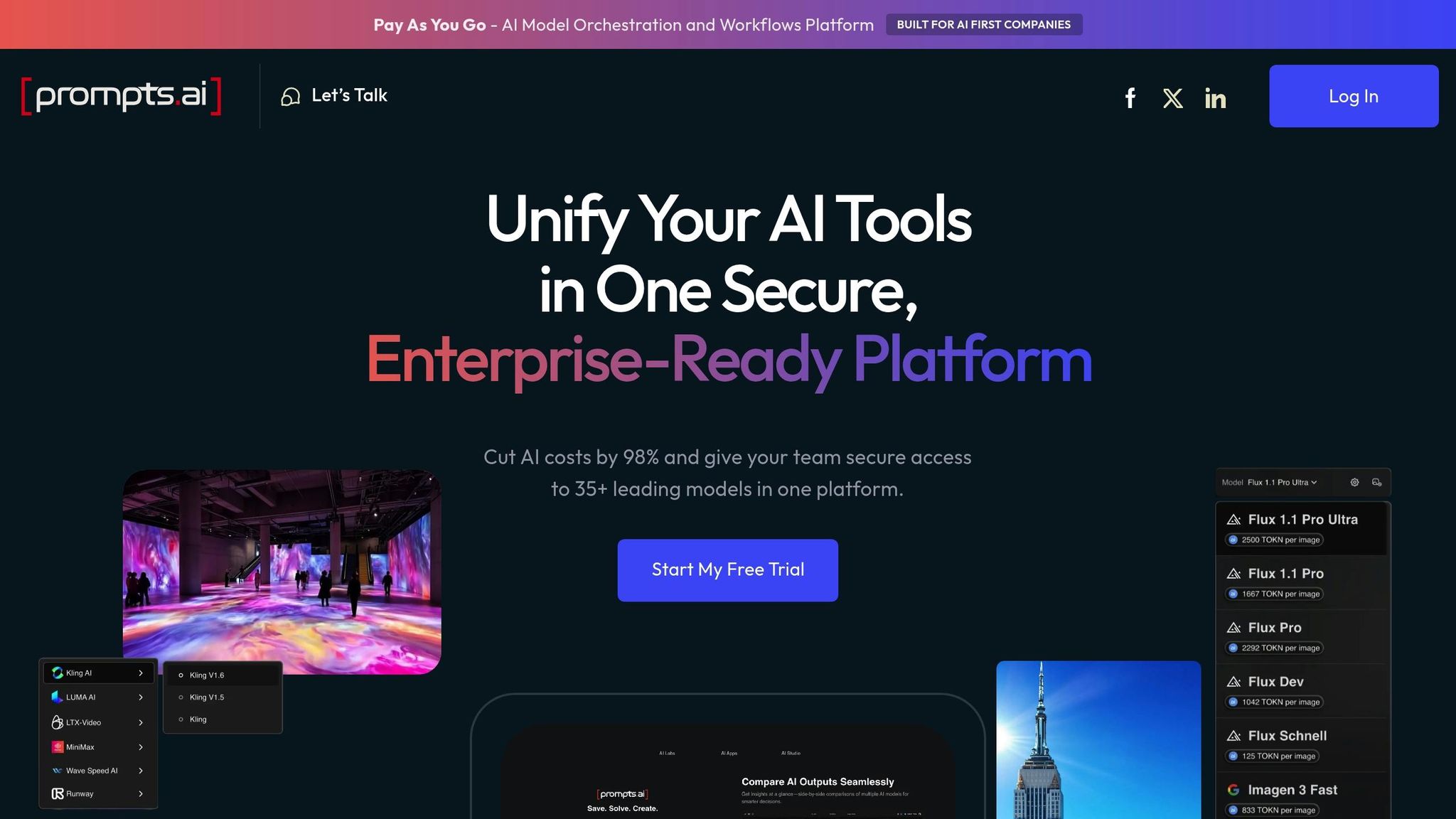
Prompts.ai is a robust AI orchestration platform designed for enterprises, bringing together over 35 large language models (including GPT-5, Claude, LLaMA, and Gemini) into one secure, streamlined interface. It tackles a major pain point for organizations: managing the chaos and hidden expenses of juggling multiple AI tools across teams.
At its heart, Prompts.ai simplifies AI management with a centralized dashboard that consolidates multiple subscriptions. This approach can cut AI software expenses by as much as 98%. By automating workflows and centralizing model operations, it effectively addresses key challenges in organizational processes.
The platform enables automation of repetitive tasks using a natural language workflow system. With customizable prompt templates, users can handle diverse tasks without needing any coding expertise. Additionally, real-time analytics and monitoring tools allow users to track workflow performance and uncover opportunities for improvement on the fly.
Prompts.ai also incorporates a FinOps layer, offering detailed visibility into token usage and tying AI spending directly to workflow outcomes. This financial transparency empowers businesses to make smarter, data-driven decisions about their AI investments.
Prompts.ai seamlessly integrates with popular tools like Slack, Google Workspace, Microsoft 365, and major CRMs. These integrations automate data transfers, task assignments, and real-time notifications, ensuring smooth operations across existing software ecosystems. For organizations with unique or legacy systems, API access supports custom integrations, making it adaptable to specialized needs. This integration-first design also supports a cost-efficient pricing model.
The platform uses a Pay-As-You-Go TOKN credit system, eliminating the need for traditional subscription fees. Costs align with actual usage, offering flexibility. Pricing starts with a free $0/month plan, followed by the Creator plan at $29/month. Business plans range from $99 to $129 per member/month, all presented in U.S. dollars.
Prompts.ai excels at automating tasks like employee onboarding, document approvals, meeting scheduling, and support ticket triage. For example, a mid-sized U.S. marketing agency adopted Prompts.ai to streamline client onboarding and campaign approvals, cutting onboarding time by 40% and removing manual approval delays. Both marketing teams and HR departments benefit from its pre-built workflow templates, which simplify everything from straightforward tasks to more intricate, multi-step processes.
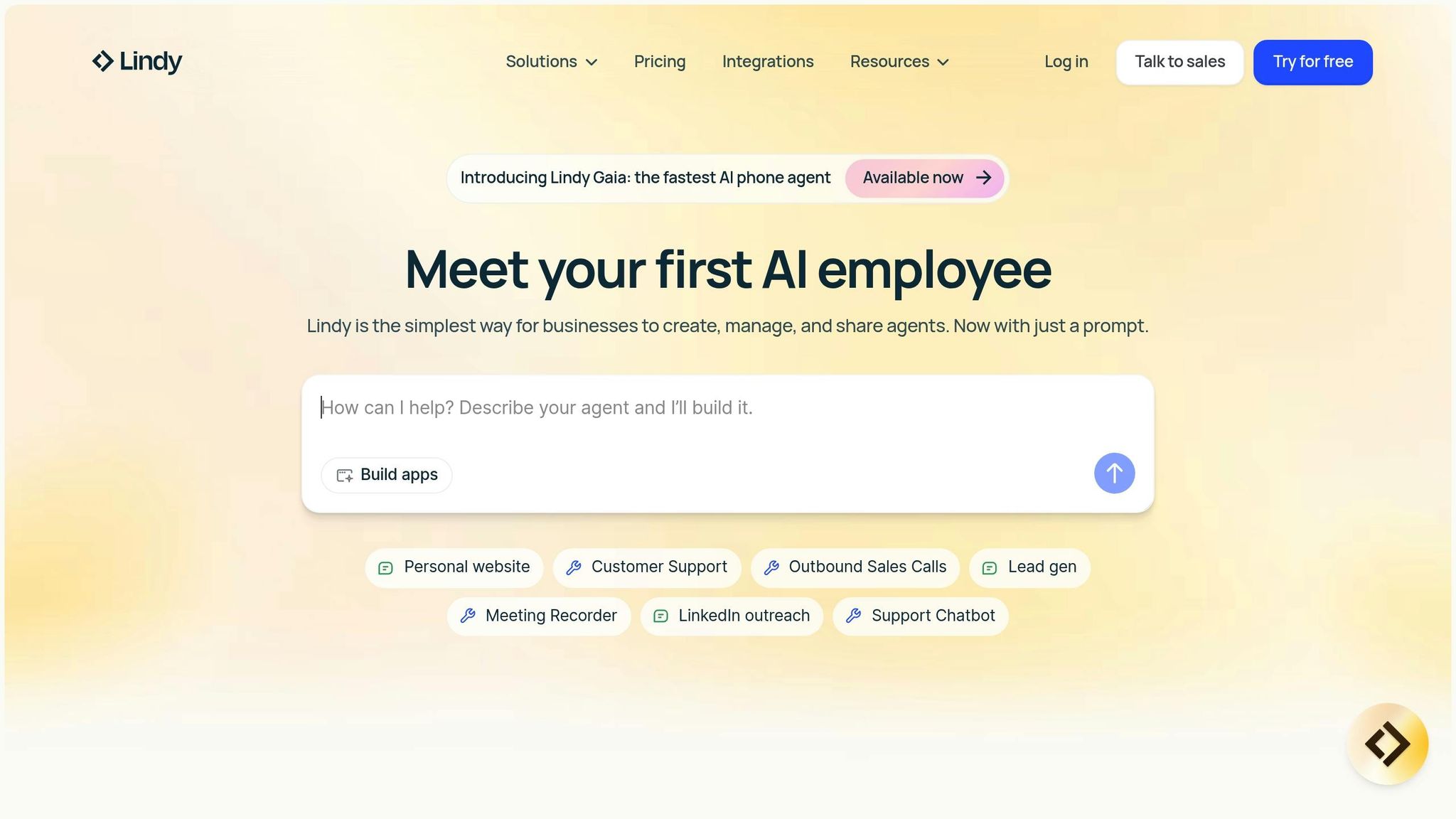
Lindy is another tool worth mentioning, though detailed information about its features, pricing, and use cases is currently unavailable. As of now, it remains under review, and this section will be updated as soon as verified details become accessible. Stay tuned for more insights.
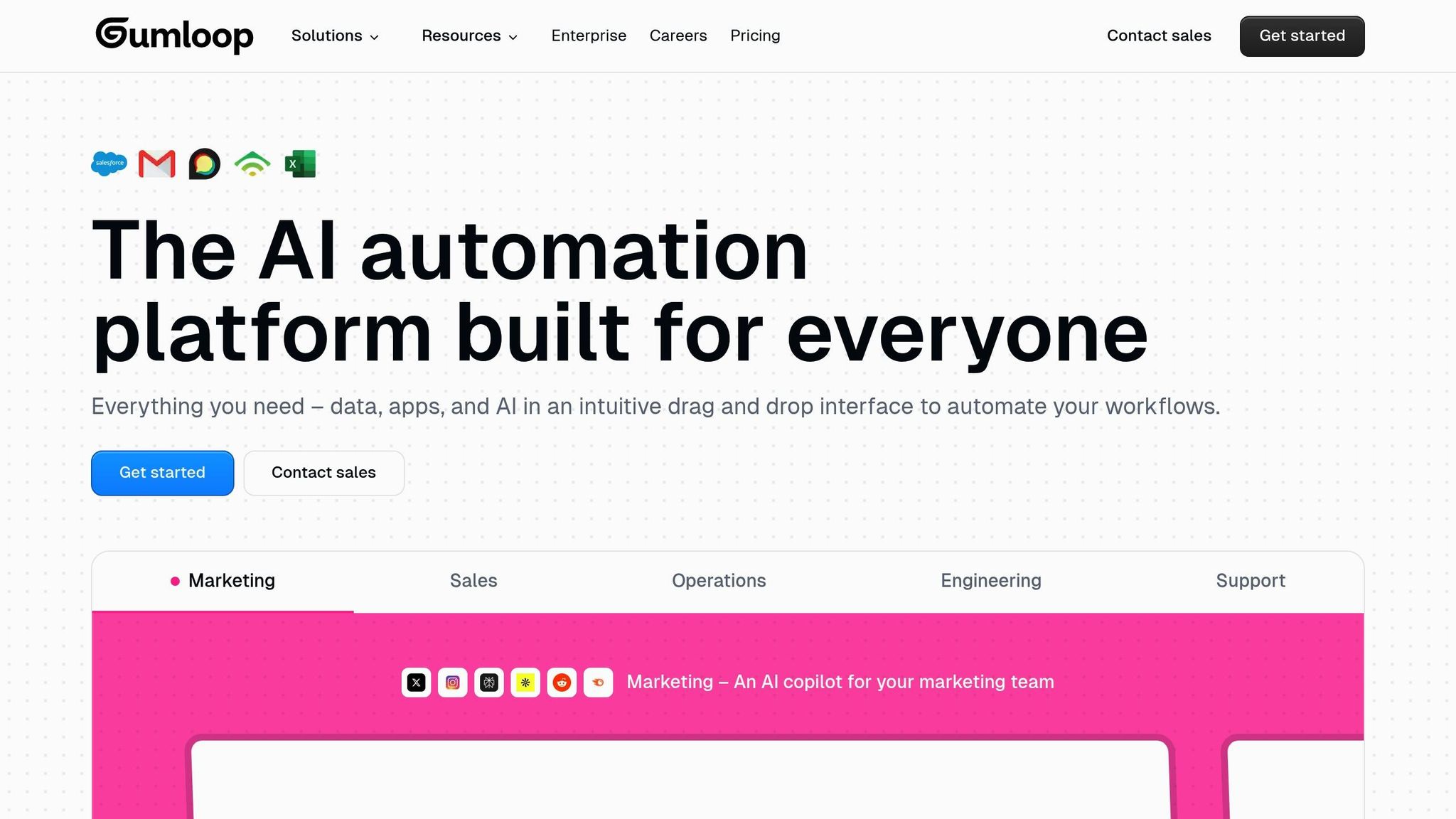
Gumloop is a no-code platform tailored for creating AI-driven business automations with a simple drag-and-drop interface. By using nodes - modular building blocks for workflows - users can design intricate automation processes without needing to write any code. This approach aligns seamlessly with centralized automation strategies.
Gumloop offers a range of capabilities that make it a standout in workflow automation. One of its key tools, Subflows, allows users to create sequences of actions within larger workflows, enabling more complex automation designs. Another useful feature, Interfaces, lets external parties input data to trigger specific automations.
A particularly notable feature is Gumloop's Chrome extension. This tool records browser actions and transforms them into repeatable automations. Whalesync highlights its value:
"This is particularly useful for tasks like web scraping or automating interactions on websites without APIs."
This feature sets Gumloop apart by enabling automation on websites that lack API support, expanding its functionality beyond traditional tools.
Gumloop primarily integrates via its Chrome extension, which is especially useful for platforms without direct API access. This browser-based functionality enables automation across virtually any web-based tool or service, making it a go-to option for tasks like web scraping and repetitive online activities.
Gumloop’s paid plans start at $97 per month.
The platform shines in a variety of automation scenarios. For instance, its internal linking opportunity finder helps content teams enhance SEO by automatically identifying and implementing linking opportunities. Legal teams can benefit from the legal contract analyzer, which streamlines document reviews. Additionally, the lead website analysis feature gathers and processes data about potential customers with ease.
Gumloop is particularly effective for automating interactions on websites that lack APIs, making it a valuable tool for businesses needing to extract data or perform actions across multiple web platforms. While highly capable, the platform leans slightly toward a technical audience. As Whalesync notes:
"Compared to Lindy, Gumloop is a bit more technical and developer-focused."
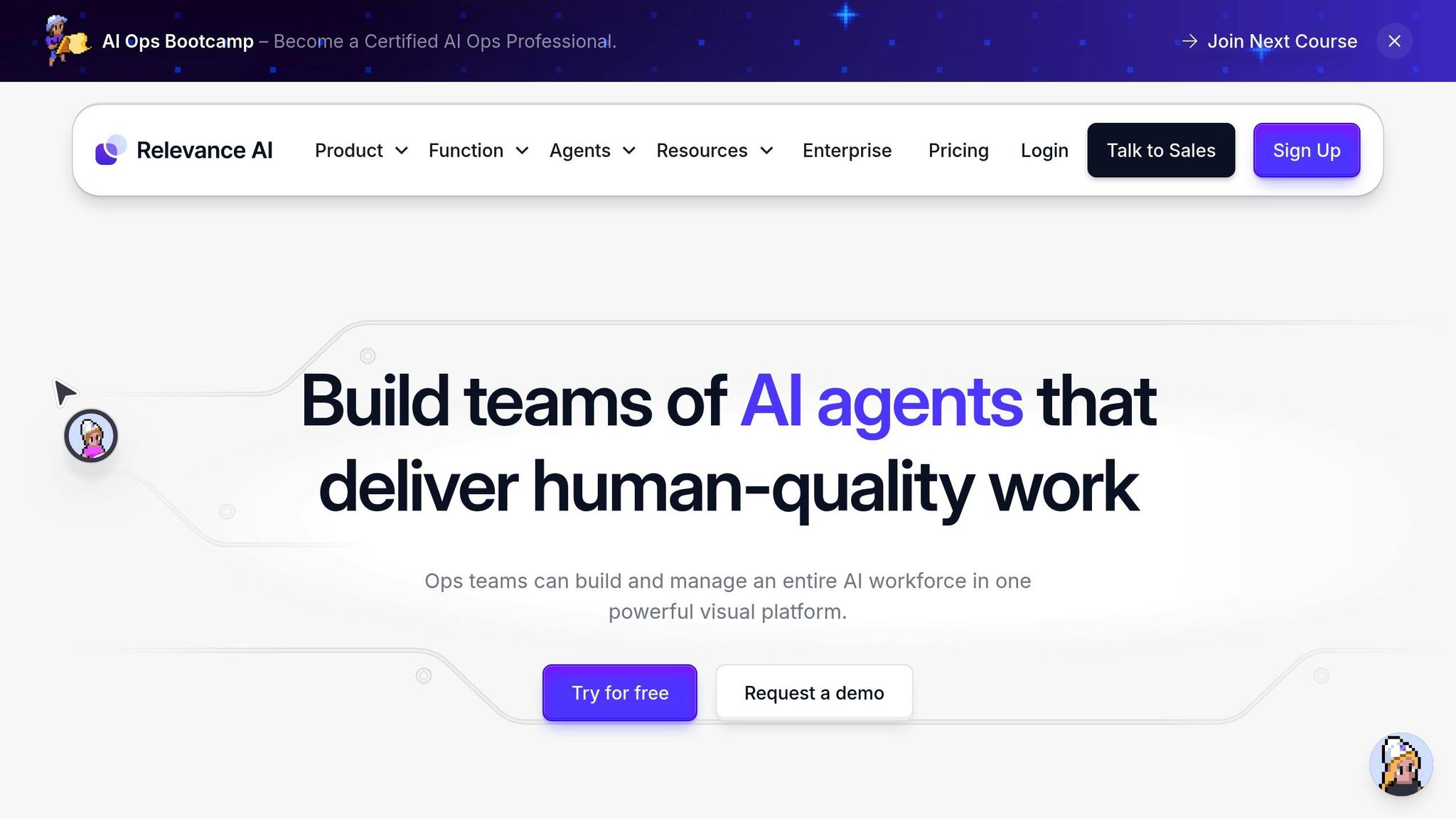
Relevance AI offers a platform designed to create custom AI agents capable of automating complex, multi-step tasks. Unlike traditional trigger-action systems, this approach uses intelligent agents to handle intricate workflows. Users simply describe their needs in plain English, and the platform builds an agent tailored to the task. This takes workflow automation to a new level, focusing on smarter, agent-driven processes.
With Relevance AI, creating an agent is straightforward. You just name the agent and provide instructions, enabling it to use pre-built tools like Google search or Slack posting. For more advanced workflows, you can link multiple sub-agents, streamlining even the most complex processes.
The platform seamlessly connects with popular business tools through its pre-built components. This includes integrations for Google search and Slack, making it easy to incorporate into existing workflows.
Relevance AI’s paid plans start at $19 per month.
Relevance AI shines in scenarios requiring intelligent, multi-step automation. For instance, agents can scrape LinkedIn data, write personalized outbound emails, and transform responses into blog posts. It’s particularly useful for tasks like content creation, lead generation, and research automation.
As Whalesync notes:
"Relevance AI starts to feel like the future of automation."
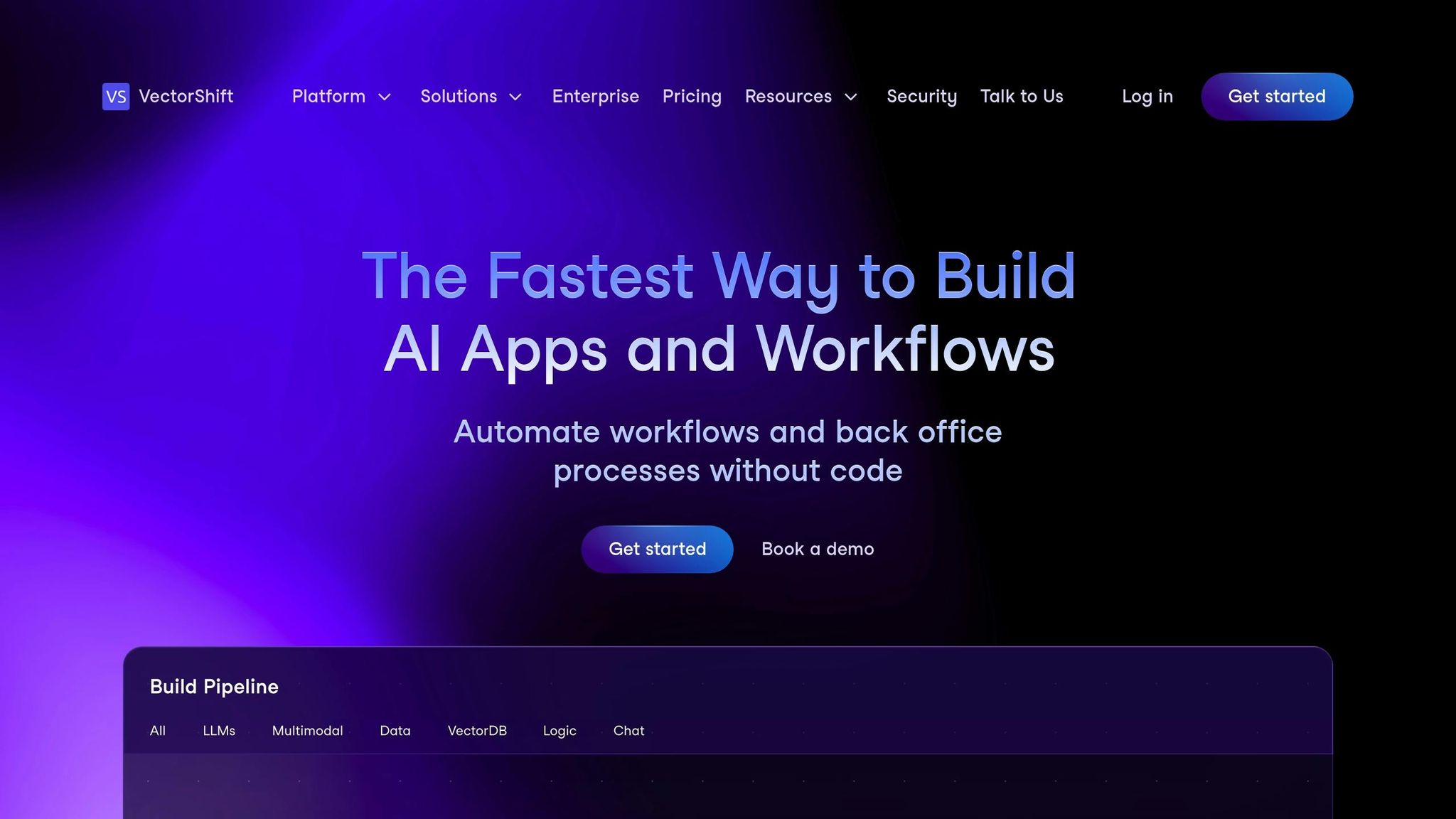
VectorShift is a no-code platform designed to simplify the creation of AI-powered workflows and applications. With its user-friendly drag-and-drop tools, it opens the door for non-technical users to harness advanced AI capabilities while still offering the flexibility required for intricate automation tasks.
At the heart of VectorShift is its visual workflow builder, which enables users to design complex AI pipelines without needing to write a single line of code. The platform supports various AI models and includes pre-built components for common functions like data processing, content creation, and decision-making logic. Users can link multiple AI operations together, forming multi-step workflows that handle tasks from data collection to delivering final results.
VectorShift also comes with built-in data connectors, making it easier to feed information into AI workflows. Real-time monitoring and debugging tools are included to help users track performance and address any issues, ensuring workflows operate efficiently in production.
The platform integrates seamlessly with popular business applications using APIs and webhooks. It supports connections to databases, cloud storage solutions, and widely used productivity tools, allowing data to flow effortlessly between existing systems and AI-driven workflows.
VectorShift offers a range of pricing options, starting with a free tier for basic usage. Paid plans are available at competitive monthly rates, with costs scaling based on usage and the features required.
VectorShift shines in projects that involve complex data processing and AI-powered decision-making. Typical applications include automated content analysis, enriching customer data, and intelligent document handling. It's particularly advantageous for businesses managing large volumes of unstructured data or those looking to develop AI-driven applications without significant development resources.

Relay.app blends AI automation with human oversight, creating a balanced system that prioritizes both efficiency and quality control. This makes it a go-to solution for businesses seeking streamlined workflows without sacrificing attention to detail.
Relay.app handles tasks like content summarization, translation, and data extraction with ease. It also allows users to design custom AI prompts, enabling tailored solutions for specific business needs - all without requiring technical expertise.
The platform's human-in-the-loop checkpoints, such as approval steps, task assignments, and data verification, ensure that critical decisions are reviewed by a human. This feature addresses concerns about fully automated systems potentially overlooking important subtleties.
Relay.app also supports the creation of complex, multi-step workflows. With tools like conditional paths and iterators, users can design decision trees and manage bulk processes, making it a powerful option for handling intricate business scenarios.
Additionally, the platform enables the creation of custom AI agents. These agents can independently manage multi-step tasks while allowing for human oversight when necessary. The system integrates seamlessly with existing tools, making implementation straightforward.
Relay.app connects with over 100 popular apps, including Airtable, Calendly, ClickUp, DocuSign, Gmail, Google Docs, Google Sheets, HubSpot, Notion, OpenAI, Salesforce, Slack, Trello, and Typeform. This extensive integration capability is complemented by flexible pricing options.
Relay.app offers a "Start for free" plan, letting businesses explore its features without upfront costs. This trial approach allows teams to experiment with automation and evaluate the platform's value before committing to a paid plan.
Relay.app shines in sales and marketing operations, automating tasks like demo requests, competitor analyses, LinkedIn content creation, and social media promotion. For operational and support roles, it simplifies processes such as meeting follow-ups by processing transcripts, automates SEO tracking, and generates daily summaries of support issues.
One standout example involves using GPT integration to parse email replies for waitlist collection, automatically saving the data to Notion databases. Users have found this process refreshingly simple compared to alternatives.
"Relay is the only tool we've used that conforms to our processes, rather than having to adjust the process to conform to the tool. It truly is the only tool we've used that feels frictionless for human-in-the-loop workflows." - Hassaan Raza, Co-Founder & CEO, Tavus
The platform's user-friendly design consistently earns praise, with many highlighting its ability to simplify complex automation challenges while maintaining a smooth, intuitive experience.
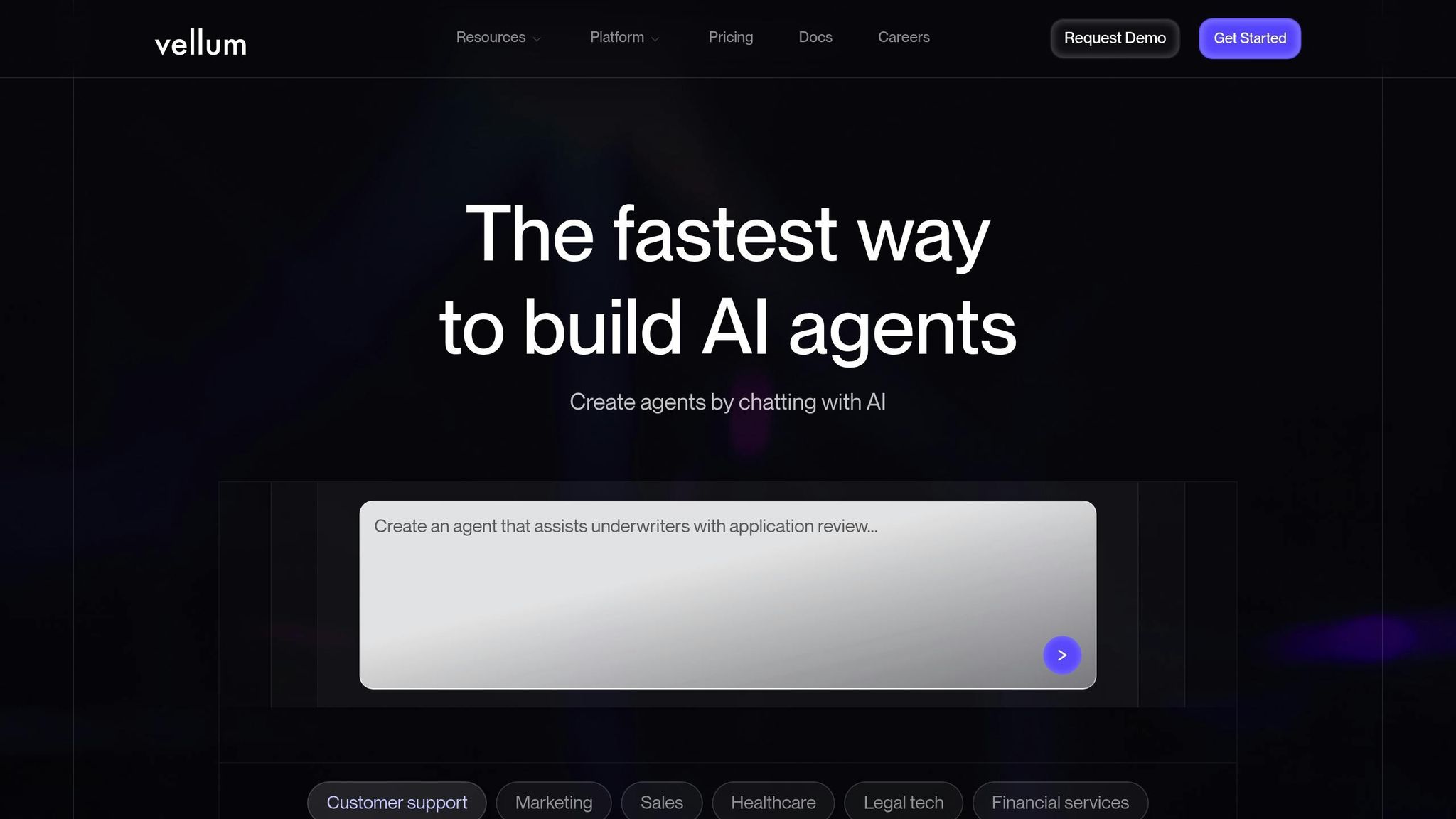
Vellum AI serves as a tool designed to streamline workflow management using AI capabilities. While it shares similarities with Lindy, specific details about its features, integrations, pricing, and practical applications remain unavailable at this time. As we continue to explore and evaluate new AI tools in this space, more detailed information about Vellum AI will be shared in future updates.
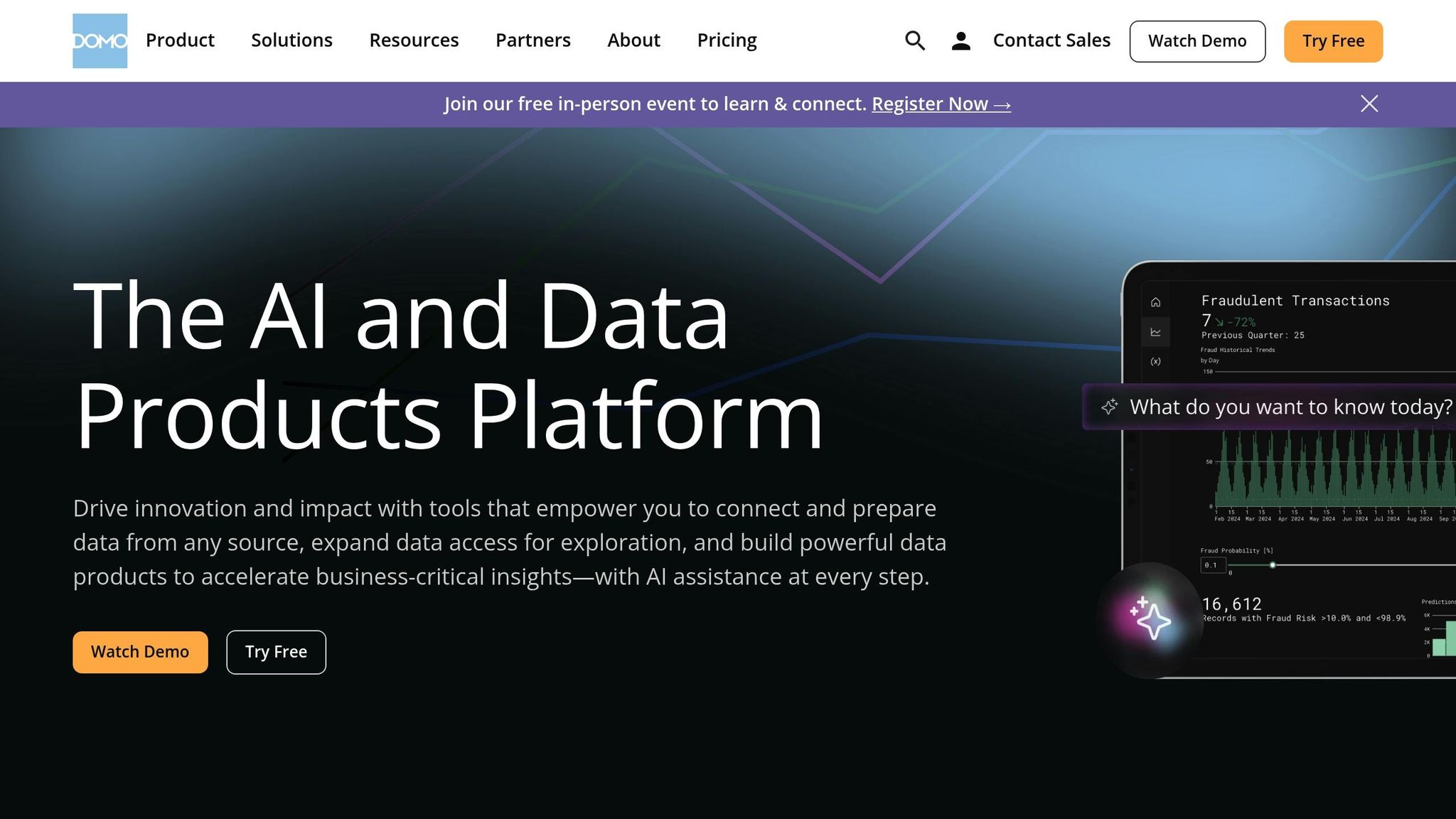
Domo is a cloud-based business intelligence platform designed to simplify workflow management and transform complex data into actionable insights. Its advanced capabilities and flexible pricing make it a strong choice for enterprises seeking efficient, data-driven workflows.
Domo's automated data pipeline and AI-powered engine take the guesswork out of data management. These tools detect anomalies, recommend improvements, and trigger actions automatically, reducing the need for manual intervention.
The Magic ETL feature provides a user-friendly, drag-and-drop interface to visually design data transformations. Users can apply filters, set up schedules, and streamline processes without needing advanced technical skills.
With Beast Mode calculations, teams can create dynamic metrics that automatically update across all dashboards and reports. This ensures consistent KPI tracking, making it easier for departments to stay aligned on performance goals.
Additional collaboration tools include commenting, task assignments, and notifications when important metrics hit predefined thresholds, keeping teams informed and connected.
Domo supports seamless integration with over 1,000 data sources, including widely used tools like Salesforce, HubSpot, Google Analytics, and Microsoft Office 365. It also connects with various database systems, ensuring smooth data flow across platforms.
The platform is mobile-friendly, allowing users to approve workflows and monitor progress on the go. This ensures operations remain uninterrupted, no matter where team members are located.
For businesses with unique needs, API access enables custom integrations with proprietary systems. Developers can create tailored automations to address specific organizational requirements, enhancing the platform's adaptability.
Domo operates on a subscription-based pricing model, starting at approximately $83 per user per month for standard features. For enterprise implementations with advanced AI capabilities and unlimited data storage, pricing is customized through discussions with Domo's sales team.
Organizations with larger user bases can take advantage of volume discounts, though costs may vary based on factors like data storage needs, the number of integrations, and specific AI workflow features.
Domo is ideal for mid-to-large enterprises that require unified, data-driven workflows. Its AI-driven insights are particularly beneficial for organizations with complex reporting needs and cross-departmental collaboration.
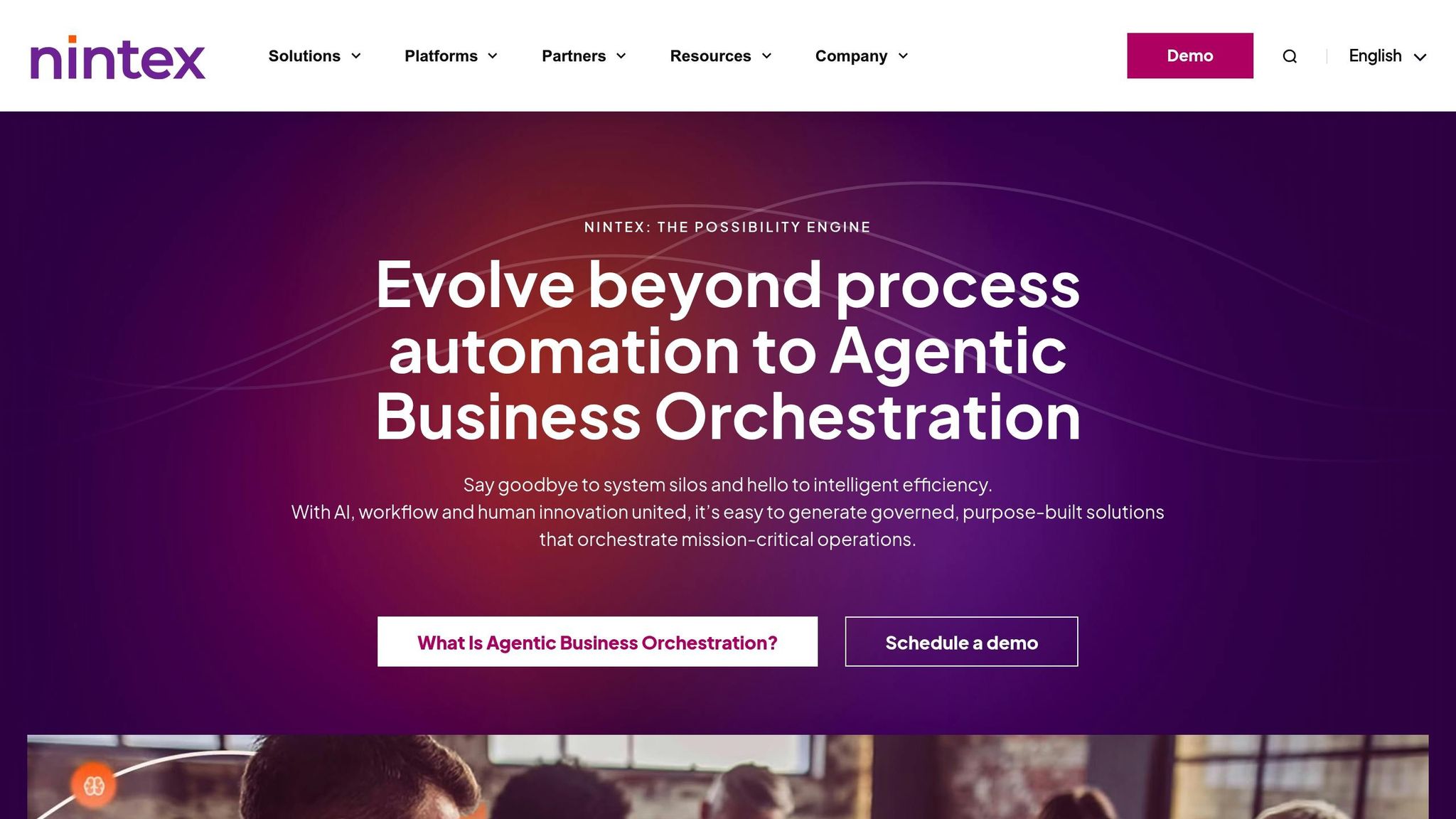
Nintex is designed to simplify and automate document-heavy and approval-based workflows, offering a solution that caters to both technical and non-technical users. As a process automation platform, it combines AI-driven workflow tools with an intuitive interface, making it easier for organizations to streamline operations.
Nintex's Process Discovery tool maps out existing workflows automatically, identifying bottlenecks and inefficiencies. This feature removes the guesswork from understanding current processes and highlights areas that need improvement.
The drag-and-drop workflow designer enables users to create detailed automation workflows without needing coding skills. Whether it’s setting up approval chains, adding conditional logic, or automating notifications, the visual interface makes the design process simple and accessible.
With Nintex RPA (Robotic Process Automation), tasks like data entry, file transfers, and system updates are automated. The platform’s AI learns from user patterns, suggesting ways to optimize processes and allowing teams to focus on more strategic tasks.
Advanced analytics and reporting provide real-time insights into workflow performance. Users can track completion rates, identify delays, and measure the impact of automation on productivity, helping teams refine and enhance their processes over time.
Nintex works seamlessly with tools like Microsoft 365, SharePoint, Teams, Salesforce, ServiceNow, and DocuSign, enabling end-to-end automation.
It also supports database connectivity with systems like SQL Server, Oracle, AWS, and Azure, allowing workflows to pull and update data across multiple platforms without manual effort.
For custom needs, the platform offers REST API capabilities, giving IT teams the flexibility to integrate Nintex with proprietary or legacy systems. This ensures older applications remain functional within the new automated environment.
Nintex pricing starts at around $25,000 per year for up to 100 users. Enterprise plans vary between $50,000 and $200,000 annually, depending on the scale and complexity of the implementation.
For organizations with high automation demands but fewer users, Nintex also offers a per-process pricing model, which charges based on the volume of automation rather than the number of users. This approach can be more budget-friendly for certain businesses.
Nintex is particularly effective for departments dealing with repetitive, document-heavy tasks, transforming manual approval workflows into efficient, automated processes. Its ability to connect multiple departments and stakeholders makes it a valuable tool for larger, more complex workflows.
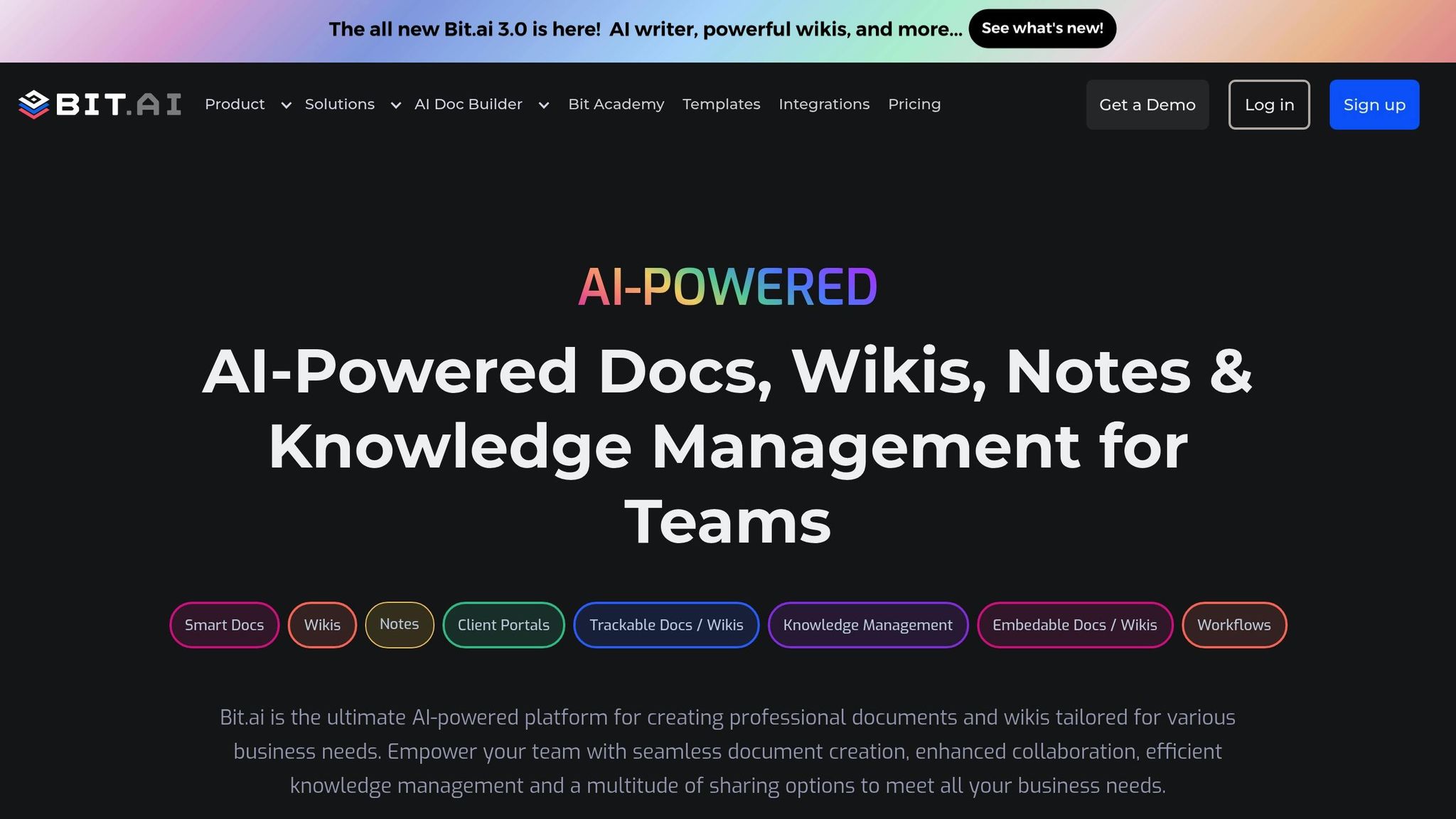
Bit.ai transforms the way documents are created and managed by combining AI-driven writing tools with dynamic content updates. Unlike traditional static document platforms, Bit.ai allows documents to automatically refresh when linked data sources are updated. This makes it an ideal solution for teams handling complex workflows with multiple stakeholders, positioning it as a central hub for integrating workflows seamlessly.
The AI Genius Assistant Writer speeds up content creation by generating templates, outlining detailed processes, conducting research, and polishing text to align with organizational standards.
With Smart Docs and Wikis, teams can create interactive documents that double as both process documentation and active workflow hubs. The platform's editor supports dynamic content, while the content tree hierarchy ensures logical organization. The Quick SLASH MENU further enhances efficiency by enabling rapid content insertion, keeping workflows uninterrupted.
For real-time collaboration, inline comments and @mentions streamline communication without breaking the flow of work.
As workflows grow, the Smart Search feature becomes indispensable. It allows users to instantly locate specific information across unlimited workspaces, folders, and documents, eliminating delays caused by searching for critical data.
Bit.ai shines with its ability to integrate with over 100 software tools, embedding content directly into workflow documents. For example, teams can insert Figma designs, Google Spreadsheets, Typeforms, or Vimeo videos into their documents. Any updates made in the original applications are automatically reflected within Bit.ai, removing the need for manual updates.
The platform supports embedding rich media, charts, presentations, and forms, creating comprehensive workflow hubs. This eliminates the inefficiency of switching between multiple apps during project execution.
Additionally, Bit.ai supports cloud file integration with real-time updates. It offers file previews for formats like PDFs, PowerPoint, Word, Excel, MP4, and MP3, ensuring seamless access to essential files.
Bit.ai offers flexible pricing plans to accommodate teams of all sizes.
While platforms like Prompts.ai and Relay.app emphasize task automation and oversight, Bit.ai excels in keeping documentation interactive and up-to-date for smoother project management.
Selecting the right AI workflow management tool hinges on your organization's unique needs, budget, and technical priorities. The ideal solution should strike a balance between robust functionality and user-friendly design, enabling teams to streamline operations without unnecessary complexity. Prompts.ai offers a compelling example of how integrated AI workflow management can meet intricate business demands.
With its ability to unify over 35 top language models into a single, secure platform, Prompts.ai eliminates the chaos of juggling multiple tools. It provides real-time insights into usage, spending, and performance, all while leveraging pay-as-you-go TOKN credits designed to reduce AI software expenses by up to 98%.
Here’s a quick look at the strengths and considerations for Prompts.ai:
| Tool | Best For | Strength | Main Limitation | Starting Price |
|---|---|---|---|---|
| Prompts.ai | Enterprise AI orchestration | Centralized multi-model management with clear cost tracking | Advanced features may be excessive for simpler needs | $0/month (Pay-as-you-go) |
This integrated approach showcases how modern AI workflow platforms can simplify operations, improve cost efficiency, and provide transparent performance tracking - all in one streamlined solution.
The AI workflow management space offers a range of tools tailored to tackle distinct organizational challenges. Choosing the right solution depends on factors like your company’s size, technical needs, and overall goals. The differences in requirements between smaller teams and large enterprises highlight the importance of aligning tools with specific demands.
For small to medium-sized businesses (SMBs), user-friendly platforms that streamline repetitive tasks and integrate effortlessly with popular applications are key. These solutions minimize the need for extensive technical expertise, making them ideal for leaner teams.
On the other hand, enterprises require robust systems that emphasize governance, security, and scalability. Platforms like Prompts.ai exemplify how unified AI orchestration can reduce tool sprawl while delivering the transparency and cost control that large organizations need.
For organizations that rely heavily on data analytics, tools capable of processing massive datasets and delivering actionable insights are invaluable. These platforms help bridge the gap between raw data and automated decision-making, allowing data-driven teams to refine workflows and boost efficiency.
When evaluating AI workflow tools, prioritize platforms with native AI capabilities and real-time data connectivity rather than relying on add-ons. Tools designed with AI at their core are better suited to adapt to dynamic business conditions, ensuring automated workflows are always up-to-date with the latest information.
Additionally, scalability and governance are critical. Look for platforms that grow with your organization while maintaining strict controls through features like permission settings, audit logs, and compliance measures.
Ultimately, success hinges on aligning the tool’s strengths with your specific workflow challenges. Whether your focus is on basic automation or advanced orchestration, the right platform should integrate smoothly into your current processes while leaving room for future expansion.
Prompts.ai makes managing costs straightforward by bringing together access to more than 35 large language models on a single platform. This setup allows for easy comparisons and streamlined control over workflows and outputs, cutting out the hassle of juggling multiple tools and reducing both overhead and complexity.
The platform also features a built-in FinOps layer, which provides real-time tracking of usage and spending. With this tool, businesses can fine-tune their expenses, keep an eye on ROI, and maximize the value of their AI investments - all while enjoying complete transparency into where their money is going.
No-code platforms such as Gumloop and VectorShift are transforming the way businesses operate, especially those without deep technical expertise. With drag-and-drop interfaces and pre-made components, these tools allow users to design AI-powered workflows and automations without needing to write any code.
This makes it possible for non-technical teams to manage workflows independently, cutting down on the reliance on developers. The benefits are clear: businesses can save time, lower expenses, and adapt faster to shifting demands, all while boosting efficiency and simplifying their processes.
Relay.app integrates human-in-the-loop steps, such as approvals and reviews, into automated workflows to maintain high standards of quality control. This method introduces human oversight at key moments, ensuring both accuracy and reliability while leveraging the speed and efficiency of AI-driven automation.
By combining human judgment with AI capabilities, Relay.app strikes a balance between precision and productivity, offering businesses a smart way to streamline processes without sacrificing quality.


